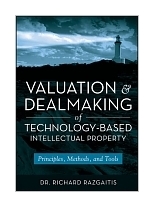|
||
podział tematyczny • wydawnictwa anglojęzyczne podział tematyczny Newsletter: • Zamów informacje o nowościach z wybranego tematu Informacje: • sposoby płatności i dostawy • kontakt • Cookies na stronie • Regulamin zakupów Szukasz książki? Pomożemy Ci! Zadzwoń 512 994 090 Napisz poczta@ksiazki24h.pl |
VALUATION AND DEALMAKING OF TECHNOLOGY-BASED INTELLECTUAL PROPERTY:RAZGAITIS R. / PRINCIPLES METHODS AND TOOLS 2ND EDITIONwydawnictwo: WILEY , rok wydania 2009, wydanie IIcena netto: Valuation and Dealmaking of Technology-Based Intellectual Property: Principles, Methods and Tools, 2nd Edition This indispensable tool provides readers with complete coverage of the issues, methods, and art of valuing and pricing of early-stage technologies including backgrounds in the core concepts, sources of value, methods of valuation, equity realizations, and negotiation strategies. Dr. Richard Razgaitis is a Senior Advisor at CRAI, an international consulting firm providing expertise in economics, finance, and business strategy. He has over thirty years of experience working with the develop-ment, commercialization, and strategic management of technology, more than twenty-five of which have been spent specializing in the commercialization of intellectual property. He has negotiated numerous commercialization agreements with clients in the United States, Europe, and the Far East, ranging from Fortune 500 to small startup companies and is the author of four books on valuation and negotiation/dealmaking published by John Wiley and Sons. Table of Contents Preface. Disclaimer. About the Author. Acknowledgments. CHAPTER 1 Introduction to Opportunity Discovery, Valuation, and Dealmaking. Introduction: Technology D-V-D. Taxonomy of Technology Licensing. High Significance, High Ambiguity Contexts. Licensing D-V-D and Innovation. Going Forward. Notes. CHAPTER 2 Risk and Reward. Uncertainty. Phronesis (Judgment). Technology Uncertainty. More on Risk. Value and Price. Two Final Points on Buying and Selling. Notes. APPROACH I OPPORTUNITY DISCOVERY. CHAPTER 3 Identifying and Prioritizing Technology Opportunities. Seller "Opportunity Space". The Technology Box. Buy-Side Expressions of Value: The Wheelbarrow. Overview of Valuation Methods. The Six Valuation Methods. Conclusion. Notes. APPROACH II VALUATION. CHAPTER 4 Method 1: Use of Industry Standards for Valuation. The Concept and Limitations of "Industry Standards". Sources of Industry Standard Data and Information. Survey Results as a Source of Industry Standards Data and Information. Proposed or Established Norms. Shopped Term Sheets and Price Lists. News Sources of License Agreement Information. Journals, Proprietary Databases, Reports, and Consultants. Published License Agreements as a Source of Industry Standards. Court Cases/Judgments as a Source of Industry Standards. Patent Pools. Lifetime and Organizational Learning. Average Error. Concluding Observations and Cautionary Notes. Appendix 4A: Outline of Agreement between DuPont and University of Houston. Notes. CHAPTER 5 Method 2: The Rating/Ranking Method, and Tool. Ubiquity of Rating/Ranking. Overview of How Rating/Ranking Can Be Used in Valuation. Groups and Grouping as a Fundamental Knowledge Forming Process. Using Rating/Ranking to Value Technology: Factor Assessment. Developing Criteria for Using Rating/Ranking for Valuation of Technologies. Illustrations of Applying the Rating/Ranking Method. Issues in Interpreting Value from a Rating/Ranking Result. Using Rating/Ranking to Value Technology: Classified Value. Uses of Rating/Ranking with Approaches and as a General Tool. Perspectives on Rating/Ranking as an Approach with Licensing. Knowledge, Uncertainty, and Humility. Conclusion. Appendix 5A: Factors in Pricing License. Notes. CHAPTER 6 Method 3: Rules of Thumb to Determine Valuation. Foundations of Rules of Thumb. Cost Savings Example of the 25 Percent Rule. Perspectives on the 25 Percent Rule. Use of the 25 Percent Rule for Apportioning New Profits. Examples of Applying the 25 Percent Rule to New Profits Licensing. A Universal Rule of Thumb Chart. Other Percent Rule Values. Some Misuses/Misapplications of the 25 Percent Rule. Other Valuation Rules of Thumb Used (or Have Been Proposed). Summary Points on the Use of the 25 Percent Rule. Conclusion. Notes. CHAPTER 7 Method 4: Discounted Cash Flow Method to Determine Valuation. Overview of the DCF Method. Basic Financial Concepts. Quantification, Classification of Risk. An Example Cash Flow Projection from a License. Additional Considerations for Calculating DCF. Segment and Scenario Analysis. Cash Flow Projections. Other Issues to Be Considered with the DCF Method. Conclusion. Sources of Information to Develop Business Projections. Notes. CHAPTER 8 Method 5: Advanced Valuation Methods. Modified Discounted Cash Flow Method. Monte Carlo Method. Real Option Methods. Conclusion. Online Resources. Appendix 8A: Example Crystal Ball Report for Exhibit 8.18. Appendix 8B: Crystal Ball Report Corresponding to the Results Presented in Exhibit 8.XX for a Double-Humped Cost Distribution Assumption. Notes. CHAPTER 9 Method 6: Valuation by Auctions. Introduction to Auctions. When Auctions are Feasible. Auction Examples. Auctions as Distinct from Other Types of Dealmaking. Auction Strategies for Buyers. Auction Caution. Conclusion. Appendix 9A: Bidder’s Agreement. Notes. APPROACH III DEALMAKING. CHAPTER 10 Approach: Deal Structure. Return to the Box and Wheelbarrow. Cash When Pricing Structures. Cash As Pricing Structures. Cash If Pricing Structures. Cash Maybe: Options. Consideration Forms Beyond Simple Cash. Special Form of Cash If: Equity. Balancing Simplicity with Comprehensiveness. Conclusion. Notes. CHAPTER 11 People, Process, and Lessons Learned. Introduction. Deal Team. Deal Targets. Negotiating Plan. Plan B. Concluding Advice from Technology Dealmakers. Notes. CHAPTER 12 In Conclusion. Approach of Opportunity Discovery as a Quest. Approach of Valuation: A Review of the Six Valuation Methods. Approach of Dealmaking. Closing Thoughts. Website Resources. Notes. Appendix: List of Abbreviations and Trademarks. Bibliography. Index. 624 pages, Hardcover
Po otrzymaniu zamówienia poinformujemy, |


